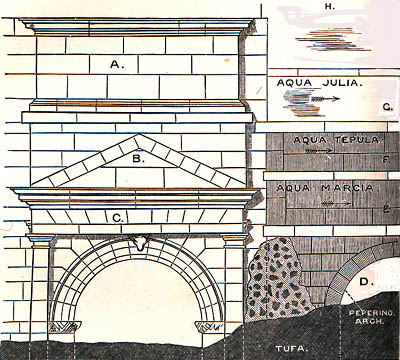
aqua

Aqueducts were one of the engineering and architectural marvels of the Roman world, making feasible large concentrations of people around a constant water supply. Aware of the strategic importance of a good water supply, Augustus introduced and gave political status to the administrative position of curator aquarum.
While some of the water systems were laid underground, most of Rome's water came into the city on magnificent, often tall arches, from the Anio River, with additional supplies from the Alban Hills. The regulations, history, distribution, and practical details of aqueduct maintenance are fully described by Sextus Julius Frontinus (c. 30-104 CE) in his two-volume work De aquis urbis Romae, begun when he was appointed curator aquarum by Nerva.
The ueteres arcus beside which the poem's narrator and Umbricius meet are those of the Aqua Marcia, at the place where it crosses the Via Appia in the Servian wall. Built in 144 B.C. by the praetor urbanus Quintus Marcius Rex, the Marcia (aqueducts were regularly named after their builder) was one of the most famous aqueducts in Rome for the coldness and purity of its water. It delivered water to the Quirinal and Viminal hills, to the top of the Capitoline, and ultimately to the Aventine also, because of its plentiful supply.
By 33 BCE the arches of Aqua Marcia supported the Aqua Tepula and Aqua Julia as well (see the image above and this drawing by Piranesi of the Porta Maggiore, the gate in the Aurelian wall which carries the Aqua Marcia, the Tepula and the Julia into Rome). Northeast of the Porta Maggiore, Aqua Marcia's construction into Rome's outer wall can be seen as far as the Porta Tiburtina (click here for aqueduct ruins in Rome).